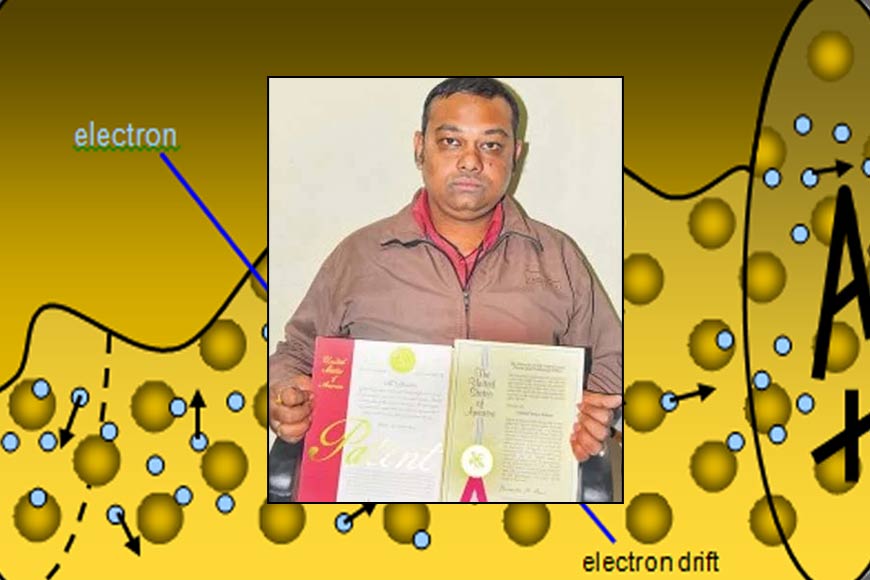Sabyasachi Haldar’s 'Free Electron Wire' receives US patent

If a stream of electrons flows through a hollow pipe, a miracle occurs that brings down power wastage to zero level. But Sabyasachi Haldar, a teenager who had just cleared his higher secondary exam, was still not aware of the impact of his invention. He must have been around 18 or 19 years old then and still quite confused about his future choice of career. Yet the youngster owned patents of six of his inventions and all which he made at home with ordinary household items strewn around any typical home!
Haldar had acquired patents for his inventions from the US, Britain and China and now, this Bengali scientist has succeeded in obtaining a patent for his ‘Free Electron Wire.’ His electric conductor is capable of functioning at room temperature. By using the device, any ‘Five Star’ rated electronic gadget can be converted to almost ‘10 Star’, which means, that the power consumption of the device will be reduced drastically. If used commercially, the new invention can revolutionize electricity consumption pattern.
When Haldar was a student of Class VIII, he had dreamt of manufacturing a machine that would run without electricity. He approached his school teacher, Parthapratim Roy, and shared his dream. Roy brushed off the suggestion saying this was not possible but suggested, he could perhaps try to build a super conductor and if he could do that, he would be closer to his dream.
Haldar is no hot-shot academic from a renowned institute nor does he have any doctoral or other professional degree attached to his name, yet he has been experimenting at home and making one discovery after another. One such invention is the 'Free Electron Wire' or 'superconductor,' which reduces the dependence on mineral oil by about 85 per cent and can revolutionize our future. An alumni of South Point School, Kolkata, Haldar first applied for a patent to the Government of India patent office on September 20, 2011. However, China was the first to respond to the request and on February 13, 2012, the Chinese government granted an international patent to Haldar after conducting research in 142 countries around the world. His invention was granted a British patent on September 3, 2014.
He waited for the coveted patent approval mail from the US. His dream was fulfilled when on April 5, 2016, the US First Mail arrived at his Garia home with the patent papers. The US authorities had sent a pair of patents – the first for the ‘Free electron wire’ and the second for the use of the wire in all electrical and electronic gadgets. Haldar has also proved the efficacy of the devices when used commercially. Haldar’s affair with science began in 1999, in his teens. He had just completed high school and had joined Bangabasi College with honours in Physics when he was first recognized as a researcher by the Ministry of Defense in 2001. The Defency Minsitry referred him to Dr Tapsaranjan Middya, Professor of Physics, Jadavpur University. Dr Middya gave him the opportunity to use the University’s internal laboratory but since he was still not a graduate, the university could not confer him the formal degree of a researcher. Due to his young age, he faced many impediments in pursuing research in established educational institutions. By then he was recognized as an inventor globally.
When Haldar was a student of Class VIII, he had dreamt of manufacturing a machine that would run without electricity. He approached his school teacher, Parthapratim Roy, and shared his dream. Roy brushed off the suggestion saying this was not possible but suggested, he could perhaps try to build a super conductor and if he could do that, he would be closer to his dream. That’s how it all began. Haldar got hooked to the idea and spent sleepless nights trying to make superconductors. But it is not all that easy. In order to be a superconductor, an object has to be moved 60 to 70 degrees below freezing. He had observed that cooling increases the electrical conductivity of matter and began researching on the rationale behind this phenomenon. Suddenly the Theory of Vacuum came to his mind.
An alumni of South Point School, Kolkata, Haldar first applied for a patent to the Government of India patent office on September 20, 2011. However, China was the first to respond to the request and on February 13, 2012, the Chinese government granted an international patent to Haldar after conducting research in 142 countries around the world. His invention was granted a British patent on September 3, 2014.
Haldar first created vacuum inside a silicone rubber and Teflon pipe by applying a ‘rotary and oil diffusion pump’. Then, using an electron gun, he filled the hollow space with electron particles. He observed that the stream of electrons was flowing smoothly and covering a long path without any collision. He used the 'Mean Free Path of Particles in Vacuum' (the mean free path is the average distance that a particle can travel between two successive collisions with other particles) feature, and invented the 'Free Electron Wire'. Usually we are used to seeing copper or aluminum wire. It is made by inserting ‘copper core’ or ‘aluminum core’ into the rubber pipe. In this case, instead of 'core', there is an electron cloud. Haldar claims that the price of his superconductor is the same as that of copper or aluminum wire. Hence, no extra expenses are involved in introducing the superconductor to replace the traditional wire. This will save energy and is cost effective as well.











